Update on North Korean Rocket Test Facilities: No Imminent Launches, But…
Summary
Despite rising tensions in the aftermath of new United Nations Security Council sanctions imposed on North Korea and Pyongyang’s pronouncements at the end of 2012 that it would conduct additional rocket tests, new commercial satellite imagery collected from January 2013 through early March show no signs of preparations for launches in the next month at either of the North’s two rocket test facilities. There have been recent signs of increased activity at the Tonghae Satellite Launching Ground. However, whether that activity is consistent with preparations for a later test, perhaps in May, is unclear since evidence at this point, which would be very early in a launch campaign, remains too ambiguous to reach that conclusion.
In addition, concerns have mounted about Pyongyang’s efforts to further develop the KN-08 road mobile missile that may be an intercontinental-range delivery system. In addition to recent reports that the system was spotted on deployment in the North, South Korean press reports in mid-February stated that the KN-08 rocket engine had been tested at the Sohae Satellite Launching Station earlier that month. Analysis of February 16 imagery, however, is inconclusive in confirming reports of an engine test five days earlier.
Construction of a new launch pad and associated facilities at Tonghae continued, but at a slow pace, perhaps because of winter weather. Nevertheless, the North has begun work on a road that could help accelerate future efforts to build the new pad.
No Sign of Near-Term Rocket Test Preparations, But…
Imagery from January 2013 through early March shows an increase in activity at the Tonghae Satellite Launching Ground (commonly referred to as “Musudan-ri”) and little activity at the newer Sohae Satellite Launching Station (commonly referred to as “Tongchang-ri”). Commercial satellite imagery from DigitalGlobe from February 11 of the Tonghae site shows that the road leading to the pad used to launch the Unha rocket in the past has been plowed and it appears the North Koreans have begun to shovel snow. Also, the crane’s position has shifted from previous pictures and is now pointing to the southwest (figure 1).
Figure 1. Old launch pad at Tonghae in February.

Eleven days later, more snow has been cleared, the crane has been repositioned to the north, and underneath it in the gantry’s shadow are two vehicles or objects (figure 2). These activities probably indicate continued work on the gantry that has been going on since last summer.
Figure 2. Old launch pad at Tonghae in March.

In addition, there appears to be increased activity at other key facilities that would be involved in a future missile test. February 11 imagery of the old missile assembly building shows the exit and entry roads plowed, the hardstand in front of the building cleared, and snow melt on the western single story side, indicating activity inside the building (figure 3).
Figure 3. Old assembly building at Tonghae in February.
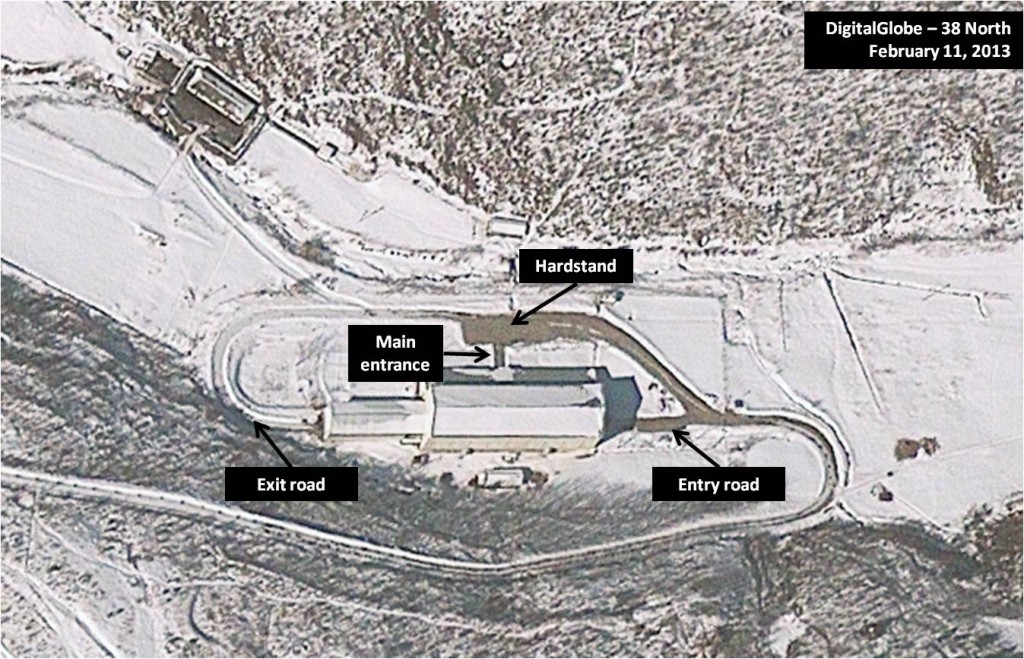
By March 1, the roads into and out of the building were completely cleared and five vehicles covered with a tarp or camouflage nets are parked just off the entrance in an area previously covered with snow (figure 4).
Figure 4. Old assembly building at Tonghae in March.
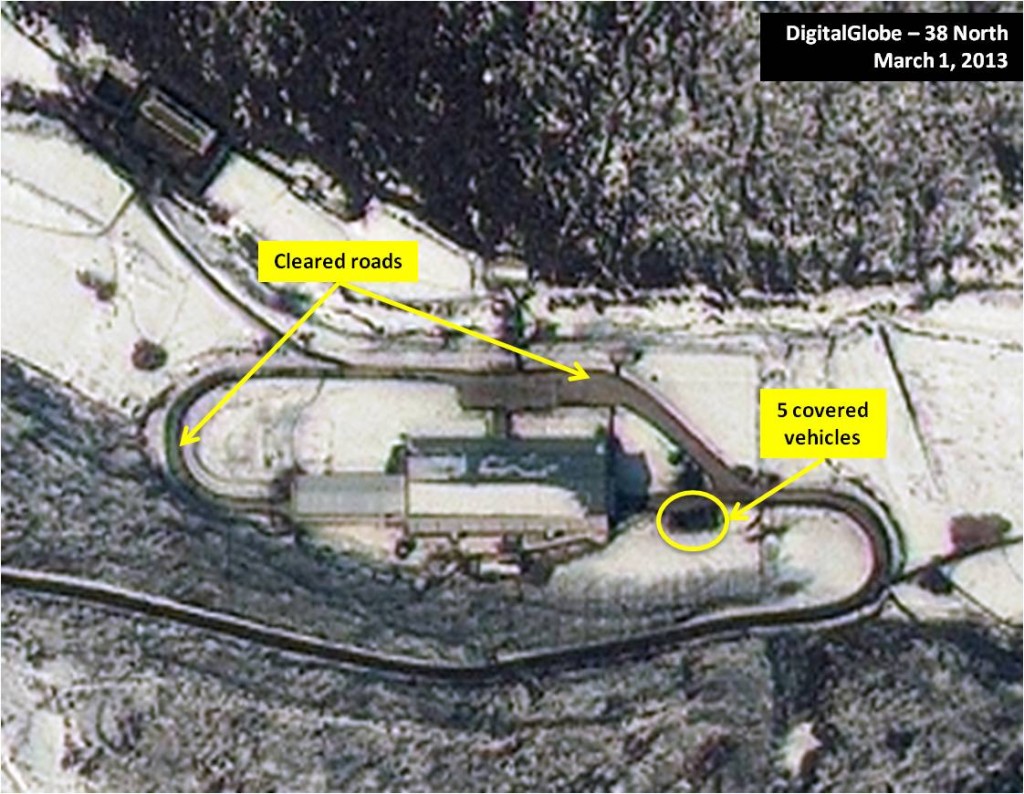
New imagery of the launch control and telemetry building show that, for the first time this year, the roads and area in front appear to be cleared. Also the two viewing ports on the building seen open on February 11 are closed by March 1. One explanation is that electronic equipment is being reinstalled inside the building, which is now heated (figure 5).
Figure 5. Launch control and telemetry building at Tonghae.
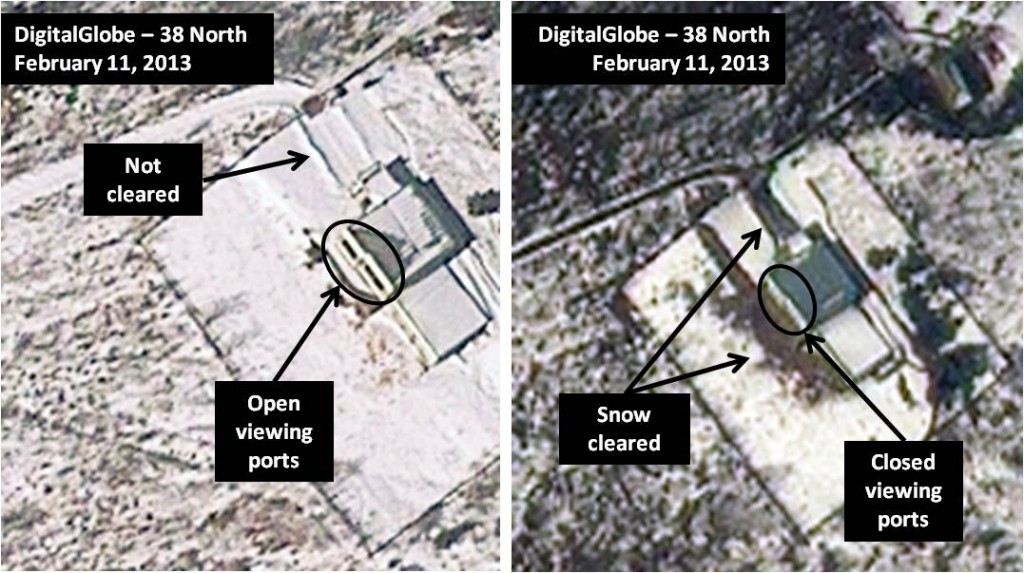
In contrast, at the newer Sohae facility, site of the December 2013 Unha-3 rocket launch, there is almost no activity except a probable security patrol path in the snow (figure 6). There are only low levels of activity at other key facilities. For instance, at the missile assembly building (figure 7), only a few vehicle tracks at the entrance are visible, but the road has not been cleared recently and neither has the exit road to the launch pad. The snow on the black hardstand in front of the building has either been cleared or melted off and there may be some limited activity inside the building. There is a lack of activity at the engine test stand.
Figure 6. Launch pad at Sohae.
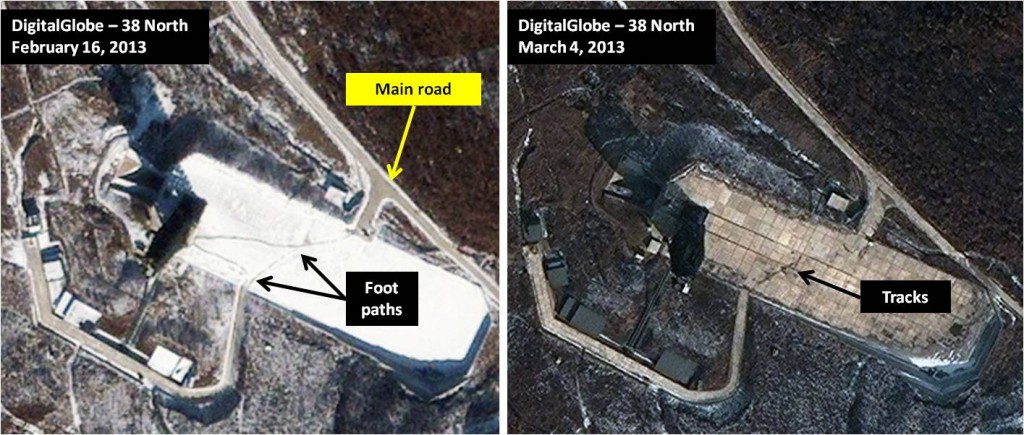
Figure 7. Assembly building at Sohae.

Future Tests?
Activity at the Tonghae site appears to fall significantly below the level of preparation necessary for a long-range rocket or satellite launch, at least over the next month. Predicting at this early stage whether activity is the beginning of preparations for a later launch is extremely difficult. While countries normally follow standard routines in preparing for rocket tests that can be useful in predicting the timing of steps prior to a launch, only one large rocket test (of the Unha-2) has been conducted at Tongahe, in April 2009. As a result, despite imagery collected beginning in February of that year, we still have a limited understanding of the timing of events leading to a test at this facility.
If Pyongyang adheres to the same timetable followed in the past, a new launch campaign will last a little over nine weeks. Two months before the April 2009 launch, the western press reported that the rocket components had left Pyongyang on a train and had arrived near Tonghae. The components were then trucked to the building where the rocket was assembled and checked out for approximately six weeks. (Two unique trailers transported the first two stages and were also kept inside the building.) Imagery on February 8, 2009, spotted two support vehicles outside the assembly building and a subsequent photo on February 17 showed personnel playing volleyball on the hardstand, possibly indicating the presence of a crew. There was also activity at the launch control center where two telemetry antennas were being installed on the roof of the single story building. At the launch pad itself, the first sign of activity was spotted on February 17: the gantry’s top four swing-out platform extensions were open. On February 24, the North Koreans announced their intention to conduct a test in early April and one day later, Kim Jong Il reportedly visited the facility.
There have been no recent press reports of rocket components leaving Pyongyang, as there were in 2009, although the most recent March imagery of three key facilities at Tonghae—the launch pad, missile assembly building and launch control building—shows activity that may indicate the very early stages of preparations for a test in May. However, we believe the evidence is still much too ambiguous to reach that conclusion. If these activities are in preparation for such a launch, it will become more apparent in the coming weeks.
Unable to Confirm Reports of KN-08 Engine Test at Sohae
Over the past month, there have been a number of press reports focusing on the North’s road mobile long-range missile, the KN-08, which was spotted in an April 2012 parade in Pyongyang and is presumably still under development. The South Korean press in mid-February stated that the KN-08 rocket engine had been tested at the Sohae facility. Such a test would be significant given what appears to be Pyongyang’s effort to further develop and deploy this system.
Based on February 16, 2013, imagery of Sohae, it is impossible to confirm or deny reports of an engine test (figure 8). Imagery analysis provides evidence both supporting and contrary to the press assertion that a test took place five days earlier and no data on whether that test was of the KN-08 engine. Data supporting the report that a test was conducted includes: 1) the road from the Sohae support area to the engine test area has been kept clear down to the concrete; 2) the engine test pad has been cleared of snow except for a light recent snowfall, while the launch pad has not been cleared; and 3) vehicle tracks seen at the assembly building could possibly be related to a recent engine test.
Figure 8. Rocket engine test stand at Sohae five days after reported test.

On the other hand, even though the February 16 photo was taken five days later, the level of activity at the site is much lower than might be expected in the aftermath of an engine test. Vehicle tracks from one probable truck entered the pad, went to its east side, then proceeded out to the test stand and left the pad. This occurred after a light snowfall. Second, unlike engine testing captured by satellite imagery in summer/fall 2012, there are no propellant tanks on or near the pad. Moreover, there are no tanks present at off-pad storage sites, unlike after the April 2012 Unha launch and previous engine tests when tanks were spotted at several sites. Third, the road to the west of the site, where optical instrumentation would observe a test, has not been cleared. Fourth, it appears that no train has been loaded or unloaded at the new rail spur since the last snow, possibly indicating that propellant tanks have not been shipped recently in or out of Sohae. Overall, the impression is that if there was an engine test on February 11, the cleanup and removal efforts were accomplished very quickly.
Continued Progress in Construction of New Tonghae Launch Facilities
A major development is the restart of work on a road that will greatly improve the delivery of construction supplies to the new launch pad (figure 9). Imagery from February 11 shows a bulldozer and large backhoe working on the road just south of the new bridge near the assembly and control buildings. It appears the North is also building an overpass over an old road and stream.
Figure 9. Road construction from the new assembly building to the launch pad at Tonghae.
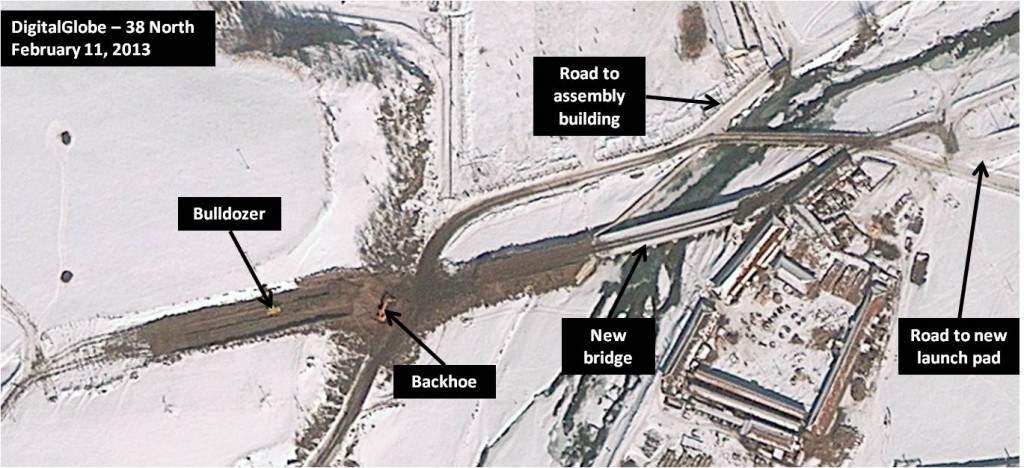
The new launch pad under construction appears much as it did in satellite imagery from early January (figure 10). There are indications that a snowmobile may bring a security team to the pad and a foot patrol occasionally walks through the site. There are also no changes at the nearly completed launch control building or the new assembly building, which still appears to be in the early stages of construction.
Figure 10. New launch pad at Tonghae.

